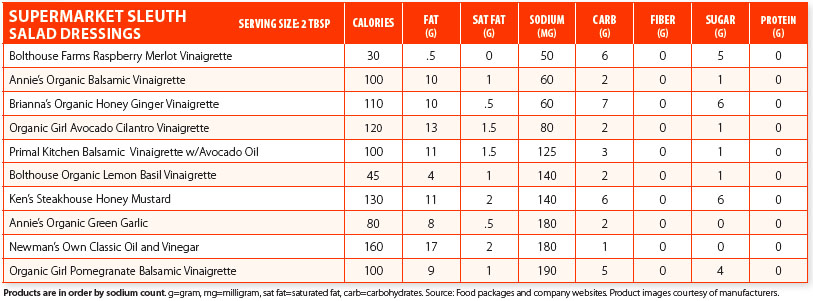Find a Healthy Salad Dressing
Salads are a great choice for consuming a wide selection of nutrients at one time. But a healthy salad can easily become unhealthy with the wrong choice of salad dressing, or too much of one. Some dressings are high fat, while others are high in sodium and even sugar. How do you know which dressing is best? Follow these suggestions.
What to Look For
Choose oil-based over cream-based dressings. A dressing made with olive oil is healthy. Olive oil contains antioxidants, is high in monounsaturated fats, and has been linked with lowering inflammatory markers.
“A cream-based dressing is usually made with buttermilk, cream, or cheese,” explains Morgan Dickison, a registered dietitian nutritionist at Weill Cornell Medicine’s Comprehensive Weight Control Center. “Dairy sources are higher in saturated fat than a dressing made with a plant-based oil, such as olive or canola, which typically is higher in healthier unsaturated fats,” she explains.
A healthy dressing also will help you absorb the nutrients from the vegetables in the salad. “Vitamins A, D, E, and K are fat soluble, meaning they need to be eaten with fat to be absorbed and available for the body to use,” Dickison says. In fact, she adds that a recent study found that monounsaturated fats such as canola and olive oil showed significant carotenoid absorption at low levels of 3 grams, and there was no further benefit as portions increased. “With saturated and polyunsaturated fat sources, the carotenoid absorption was dose dependent, meaning you needed to have a larger portion to get the same effect, resulting in consumption of higher calories.”
Next, look for low or no sodium. Compare the sodium amounts on the back of each bottle. Popular brands can easily run from 200 to 400 milligrams (mg) per serving, which is equivalent to two tablespoons. On the other hand, Bolthouse Farms, Annie’s, Brianna’s, and Organic Girl all have options with sodium under 100 mg per serving (see our chart below).
You also will find brands made with all-organic ingredients, which means fewer total ingredients, as well as no additives or preservatives. Many options are also vegan or gluten-free.
Beware Unhealthy Ingredients
“Be careful of low-fat dressings, because they often will add sugar,” Dickison says. “Try looking for ‘lite’ rather than ‘low-fat.’ Also, sweeter dressing, such as those with fruit, may have added sugar, so always look for that. Try to keep ‘total’ sugars to a minimum as well. Even though natural sugars are more easily absorbed, their calories can still add up. Dressings that might be hiding added sugar include raspberry, honey mustard, thousand island, and balsamic vinaigrette, while buttermilk ranch and bleu cheese could be high in saturated fat,” Dickison says.
Make Your Own
Typical vinaigrettes call for a 3:1 ratio of oil to vinegar. Season with one-third to a half of a teaspoon of pepper. For additional flavoring, try lemon, Dijon, rosemary, garlic, shallots, or hot peppers.

The post Find a Healthy Salad Dressing appeared first on University Health News.

